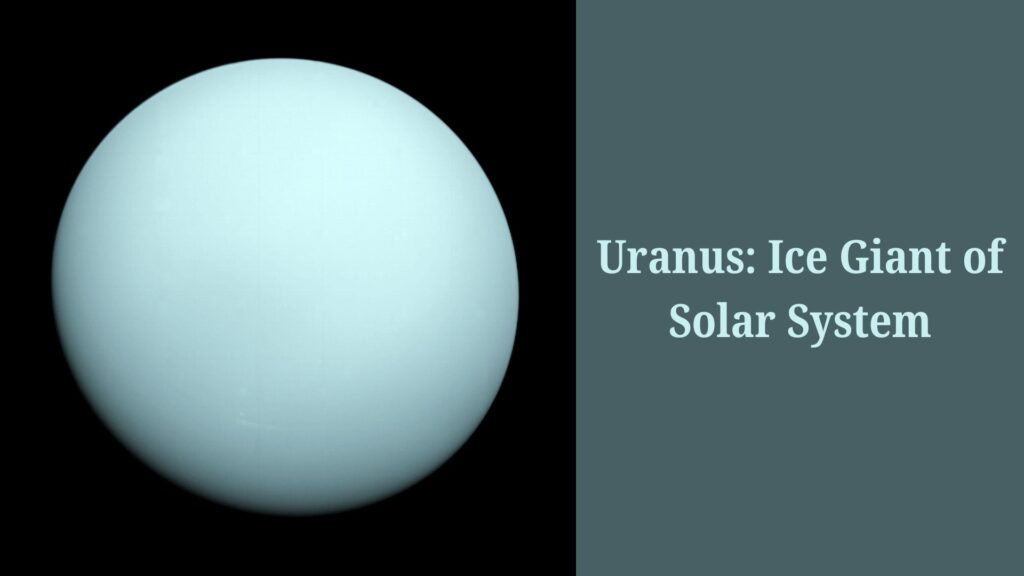

Uranus, the seventh planet from the Sun, occupies a unique location in our solar system. Since its discovery, this ice giant has piqued the interest of astronomers and stargazers alike, because to its remarkable bluish green color and unusual orientation. Uranus, with its peculiar tilt, ice composition, and faint ring system, is one of the most intriguing planets in our universe. This article discusses the planet’s physical properties, atmosphere, moons, rings, exploration history, and importance in comprehending planetary science.
Discovery and Naming of Uranus
Uranus was discovered on March 13, 1781, by the British scientist William Herschel. Unlike the five planets accessible to the naked eye (Mercury, Venus, Mars, Jupiter, and Saturn), Uranus was the first planet discovered using a telescope. Herschel first believed he had seen a comet, but subsequent examinations revealed that it was a planet, tripling the known size of the solar system at the time.
The planet is named after Uranus, the Greek deity of the sky, who was regarded Cronus’ (Saturn’s) father and Zeus’ grandfather. This mythical lineage emphasizes the relationship between Uranus and the other outer planets in the solar system.
Physical Characteristics
Uranus is the third-largest planet in terms of diameter, spanning approximately 50,724 kilometers across its equator. However, it is less massive than Neptune, ranking as the fourth-largest planet by mass. Its volume is approximately 63 times higher than Earth’s, but its mass is just 14.5 times that of Earth, resulting in a low density.
Uranus, an ice giant, is very different from Jupiter and Saturn, which are gas giants. While the latter are largely made up of hydrogen and helium, Uranus includes a larger proportion of “ices,” such as water, ammonia, and methane, along with lesser amounts of hydrogen and helium.
Atmosphere
Uranus’ atmosphere is one of the coldest in the solar system, with temperatures as low as -224°C (-371°F). It is mostly made up of hydrogen (83%), helium (15%), and roughly 2% methane. The methane in Uranus’ upper atmosphere absorbs red light from the Sun while reflecting blue and green light, giving the planet its characteristic hue.
Uranus’ atmosphere also contains weak cloud bands and occasional storm activity. These clouds are made up of water and ammonia ice, and their movement is propelled by powerful winds that may reach speeds of up to 900 kilometers per hour.
The Unique Tilt of Uranus
One of Uranus’ most intriguing characteristics is its extraordinary axial tilt of 97.77 degrees. Unlike other planets, which revolve upright or slightly slanted on their axis, Uranus is practically on its side. Because of its peculiar orientation, the poles rather than the equator face the Sun during its orbit.
The tilt is thought to have been generated by a major collision with an Earth-sized object early in the planet’s existence. The end effect is an amazing sequence of seasons, with each pole experiencing 42 years of uninterrupted sunlight followed by 42 years of darkness. The equator, on the other hand, experiences sunshine and darkness in more traditional day-night cycles.
The Rings of Uranus
Uranus’ rings are less conspicuous than Saturn’s, although there are 13 recognized. These rings are black and thin, made up mostly of microscopic particles of water ice and other elements. They were found in 1977 during a stellar occultation, which occurs when a planet passes in front of a star and temporarily blocks its light.
The rings are assumed to be quite young and may have originated from the remains of moons smashed by impacts. The brightest and largest ring, known as the Epsilon ring, is surrounded by fainter inner rings that add to Uranus’ cosmic beauty.
Moons of Uranus
Uranus has 27 known moons, each named after a figure from William Shakespeare or Alexander Pope’s writings. Scientists are particularly interested in the five biggest moons—Titania, Oberon, Ariel, Umbriel, and Miranda—because of their different surfaces and probable geological activity.
Titania and Oberon
Titania and Oberon, the planet’s two biggest moons, are about equal parts rock and ice. Titania, the biggest, exhibits evidence of old geological processes, with vast canyons and valleys on its surface. Oberon, albeit somewhat smaller, is more extensively cratered, indicating an older and less active surface.
Ariel and Umbriel
Ariel is Uranus’s brightest moon and has the youngest surface, indicating historical resurfacing activities such as ice volcanism. In contrast, Umbriel is the darkest moon, with ancient craters covering its surface.
Mirinda
Miranda, the smallest of the five main moons, is perhaps the most interesting. It has a diverse topography, including towering cliffs, steep gorges, and areas of gentle plains. Scientists believe its jumbled appearance is the product of several tectonic and impact events.
Exploration of Uranus
Only one spacecraft has visited Uranus: NASA’s Voyager 2, which passed by it in January 1986. During its brief flyby, Voyager 2 gave crucial information on Uranus’ atmosphere, rings, moons, and magnetic field. The satellite provided facts about the planet’s extraordinary tilt, faint cloud patterns, and unusually low interior heat.
Since the Voyager 2 flyby, no missions have targeted Uranus. Astronomers continue to examine the globe using telescopes like the Hubble Space Telescope and ground-based observatories. Future expeditions to Uranus have been planned, as researching this ice giant might give valuable insights into the origin and development of planetary systems.
Magnetic field
Uranus’ magnetic field is another unique characteristic. Unlike Earth’s, which is generally aligned with its rotational axis, Uranus’ magnetic field is inclined by approximately 59 degrees and displaced from the planet’s core. Because of this imbalance, the intensity of the magnetic field varies greatly over the planet’s surface.
Scientists think that this uneven magnetic field is caused by a dynamo effect in a layer of electrically conducting fluids within Uranus’ innards. The study of this magnetic field may give information on the activities taking place deep beneath the planet.
Importance of Studying Uranus
Studying Uranus is critical for understanding the diversity of planets in our solar system and beyond. Uranus is an ice giant, which distinguishes it from gas giants and terrestrial planets. Investigating its composition, atmosphere, and moons can help scientists better understand the mechanisms that form planetary systems.
Furthermore, investigating Uranus’s unusual tilt and magnetic field might shed light on the implications of major impacts and the dynamics of planetary innards. Understanding Uranus may also help us look for comparable exoplanets circling other stars, since many found exoplanets resemble our solar system’s ice giants.
Conclusion
Uranus is a mysterious planet, with a tilted rotation and ice composition, as well as faint rings and several moons. Although it is one among the least researched worlds, more research has the potential to improve our knowledge of the solar system’s history and the nature of planets beyond. As humankind considers the future of space travel, Uranus emerges as a tempting destination, enticing us to discover its mysteries and broaden our understanding of the universe.
